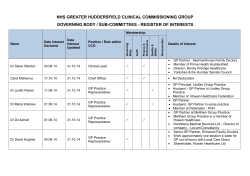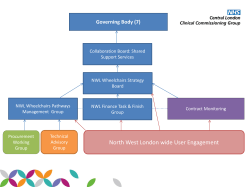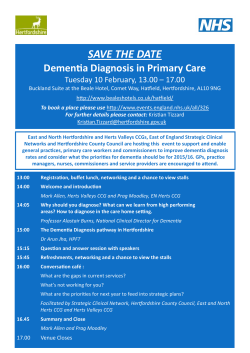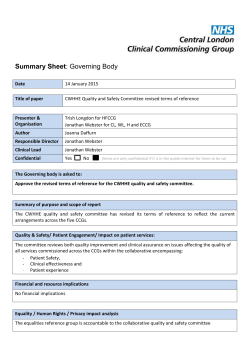
CCG Governing Body - Part I - Blackpool Clinical Commissioning
CCG Governing Body - Part I 31 March 2015 Budgets for 2015/16 Introduction 1. This report is to propose the budget for the CCG in 2015/16. It has been discussed at length by the Finance and Performance Committee and issues raised there have been included in the report. 2. The Governing Body is advised that the CCG’s financial standing deteriorated markedly during 2014/15, mainly as a result of substantial increases in expenditure rates for non-elective admissions, prescribing and continuing healthcare spending. This year the CCG has some major judgements to make with regard to the balance between commissioning services at the current high activity levels and developing new services as part of the transformation programme. The high activity levels experienced in 2014/15 has put the transformation programme at risk, to the extent that the CCG cannot now invest as much as originally planned in the services for Extensive Care, community and primary care. However, it may still be possible for the CCG and its partners on the Fylde Coast to be able to realise and even exceed their ambitions for the development of out of hospital services. The opportunity is the achievement of Vanguard status, but the partners on the Fylde Coast are likely to need to have at least started on the transformation journey before any further resources are likely to become available from national sources. Policy context 3. The national policies driving the financials in the NHS at present are detailed in: 'The Five Year Forward View'; 'The Forward View into Action - Planning for 2015/16'; and 'Supplementary Information for Commissioner planning 2015/16'. The main aspects impacting on finances can be summarised thus: • • • • • • • CCGs and NHS England commissioners must achieve all NHS Constitution standards, such at A&E, ambulance, RTT, cancer and diagnostics targets. Ensure acute services are sufficiently resilient to be able to meet patients' needs safely across the year and also at the most busy times. Allocation of growth for mental health services equivalent to the CCGs overall percentage uplift. Having plans with providers that move the local health and social care economy towards a longer-term vision for more clinically and financially sustainable services. Maintaining a sufficient contingency fund to enable the CCG to be able to cover variations in activity levels from agreed contracts. Delivery of a 1% recurring surplus. Delivery of a 1% in year surplus. 2015/16 Allocations 4. The CCG has received a 3.03% uplift on its recurring programme allotment of £6.898m. This includes £1.24m for resilience funding (about 0.5% of our allocation) and it is expected that this sum will be spent broadly on the NR schemes that were funded by NR resilience money in 2014/15 – in short it is already committed. The minimum uplift received by any CCG in England was 1.94% inclusive of the resilience funding. Some CCGs have received an uplift of over 6% in 2015/16. The total programme allotment in 2015/16 is £237.656m. 1 CCG Governing Body - Part I 5. If the CCG had in its baseline the balance of £1.9m that was the shortfall arising from the erroneous allocation reduction in respect of specialist services, it would not have received the 3.03% uplift; the amount would have been smaller. In fact the CCG received about £1.8m more than it was expecting for an uplift. Therefore it is now possible to state that the CCG no longer has a shortfall arising from the specialist services reduction. 6. The CCG has also received an amount for the Better Care Fund of £4.142m, which is not new money, but rather is money spent in local authorities that previously came via NHS England and is now expected to flow to Blackpool Council via the CCG. 7. The RCA has been reduced by £0.419m, falling to £3.527m. 8. The CCG is now 1.27 % below its target share of the overall allocation for England. For all intents and purposes the CCG would be assessed as being on target, given that the margin is so small. 9. The table below shows the allocations for 2014/15 through to 2015/16: Table showing allocations Notified allocation for programme spending Uplift SCT transfer Other recurrent Adjustments Resilience Funding(N/R in 2014/15) BCF (not new money) Sub total programme allotment RCA allotment Total Recurring Allocation NR – surplus from previous year Total Allocation 2014/15 £000 222,103 4,753 1,000 (2) 227,854 3,946 231,800 2,305 234,105 2015/16 £000 227,854 5,658 1,240 4,142 238,894 3,527 242,421 2,331 243,512 10. In addition to the total allocation above the CCG expects to receive circa £22m to be able to co-commission primary medical services with NHS England from 1st April 2015. This will take the allocation to about £264m. As part of the devolution agreement, the CCG expects NHS England to be able to allocate an extra 1% above the planned spending figure to enable the CCG to deliver 1% on its new total allocation including primary care. 2 CCG Governing Body - Part I Issues for Blackpool CCG in relation to the Five Year Forward View and Business Rules 11. Referral to Treatment (RTT) target - at present we do not have sufficient information to be able to ascertain precisely how much activity the CCG needs to purchase. The relationship between the RTT and activity levels is not simple because the RTT is about the proportion of patients treated out of a total cohort (90% within 18 weeks of referral from a GP) rather than an absolute number. For 2015/16 we have proposed to keep activity levels at 2014/15 outturn, which has been sufficient to deliver the RTT across all specialties except T&O at BTH. 12. The CCG has agreed with BTH that we will undertake a review of the activity requirements for sustainable RTT achievement using a third party and use this to determine a more scientific approach to setting activity levels for the future. The scope of this review will need to be agreed in the near future. 13. Spending on diagnostics has increased during 2014/15 by £0.5m or 14% compared to 2013/14 and it has been assumed that this level will continue into 2015/16, but no further growth will occur. A potential risk here is that any new cancer campaigns will raise demand for diagnostics above this level, but given that there were similar campaigns in 2014/15 it could be argued that the right level of activity is being commissioned. 14. Urgent care - this has been the major risk for the CCG in 2014/15 but the main consequence will be felt in 2015/16. Non-elective activity levels are 9% above plan (the plan was based on 2013/14 outturn) and around 10% higher in monetary terms. The financial impact in 2015/16 has been more difficult to determine because of the move from an assured value contract for non-electives in 2014/15 to a full PbR contract in 2015/16. The complicating factor is the non-elective threshold rules that stipulate that the financial value of all non-elective activity above an agreed baseline (2009/10 levels) can only be charged at marginal rates by providers. The marginal rate has recently been increased from 30% in 2014/15 to 70% in 2015/16 as part of the Enhanced Tariff Option (ETO) that was chosen by BTH to underpin payment in 2015/16. The Finance and Performance Committee had previously been briefed on the two tariff options (ETO and DTR). The extra cost of the move to ETO (30% to 70%) for the marginal rate on non-electives is about £2.5m, but this is complicated by the fact that the CCG paid BTH under an assured value contract for non-electives in 2014/15. 15. For 2015/16 the CCG has proposed to set the contract baselines for NEL at 2014/15 outturn with a plan to reduce them by 700 (3.5%) which is to give effect to the Better Care Fund (BCF) plans. This means that the CCG must underperform on its non-elective contracts by 700 in order to show the savings made. Given the exceptional increase in non-elective admissions in 2014/15 compared to previous years, this must be considered a major risk for the CCG. The plans to deliver this reduction are: • • For the investment of £5 per head in General Practices, each practice has developed schemes to be able to achieve the required reduction in non-electives - this works out at about 32 non-electives for the year (less than one per week) per practice, but this is against a rising trend. The first team for the Extensive Care service will be up and running from late June 2015 and the full complement of patients from the end of October 2015. It is not clear what impact there will be in nonelective admissions, but the CCG should expect there to be an impact. By October there should be about 500 patients in the service based at Moor Park and it may be reasonable to presume that perhaps one quarter of all the non electives that could have occurred could be avoided, which would equal about 150 spells saving around £0.3m. 3 CCG Governing Body - Part I • • • • Enhanced primary care services are being developed. £0.3m extra will be invested in district nursing services to enable resources devoted to neighbourhood working to be fairly distributed, but this extra money will not buy more services per se. However, one of the main objectives of this strategic development is to achieve a higher level of integration at neighbourhood level to improve treatment and care for patients outside of hospital, avoid admissions and, in time, to improve decisions on elective treatment options, perhaps enabling more cost effective solutions to be adopted. The CCG must also plan to invest the money it has received for greater resilience (£1.24m) on schemes that will enable the local health and social care economy to be able to cope better with spikes in demand during busy periods. The schemes that were implemented in 2014/15 are in the process of being evaluated and their continuation, or implementation of new schemes, will be agreed post contract sign off. Demand on Ambulance services in 2014/15 has been considerable and the Blackpool Ambulance commissioners are in discussions with NWAS and Arriva on the contracts for 2015/16. The estimate for the extra cost in 2015/16 is £0.664m and this is the amount that has been provided for in the budget. However, commissioners are in discussions with NWAS and the contract discussion process is proving difficult to conclude, which could lead to revisions to these estimates. £0.4m has been reserved in line with national mental health policy requirements, for developments in these services. The detail of how this money will be spent has yet to be agreed with providers of mental health services (BTH and LCFT). 16. As at the time of writing this report the contracts for acute, community and mental health services have not been concluded. If it is not possible to conclude the negotiations from within the amounts that have been reserved as part of the budget proposals within this paper, small variations could be accommodated from the contingency reserve. However, any large variations (say +£0.5m for BTH and the same for the totality of other providers) would require significant revisions to the CCG’s plans and therefore require further approval. If resolution of some contracts were to go to formal contract mediation and the CCG were to lose the argument, the only option for accommodating a significant change would be to increase the savings programme. Other financial issues 17. In 2014/15 the following budgets are forecasted to over-perform significantly against budgets: • • • • Continuing healthcare (CHC) by £1.4m. This follows on from the previous year when the spending pattern was flat and not rising. It is proposed to fund the budget at the outturn level, but no more. Prescribing, which is forecasted to overspend by £0.9m in 2014/15. It is proposed that this amount is funded in 2015/16 with no provision for further growth in expenditure. A savings programme is being developed and will be in place for most of 2015/16 and if the CCG is able to make savings from this baseline, that will give us some flexibility to be able to contain pressures that may arise in other areas, such as in CHC. Other acute providers - it is proposed to set budgets at 2014/15 outturn levels, where there have been substantial over-performance against contracts (£1.3m). Running Cost Allowance (RCA) - the Committee will be aware that the RCA has reduced by 10%, which is equivalent to over £0.4m. This money was taken off the CCG as part of the allocation process and presumably has enabled NHS England to increase the overall programme pot for CCGs nationally. Budgets for 2015/16 have been set for running costs within this overall sum, mainly by reducing non- 4 CCG Governing Body - Part I pay costs at the CCG, of which the contribution from the CSU was substantial. The CCG has virtually no flexibility to be able to accommodate any further costs that may arise in 2015/16 above and beyond what has been budgeted. On-going expenditure savings 18. In 2014/15 the CCG planned to save £2.4m from acute services through investments in new services designed to deflect activity away from non-elective admissions, A&E attendances and ambulance conveyances. The planned developments for children’s outpatients were not made and no agreement was reached in 2014/15 on changes to children’s services in order to reduce non-elective admissions. The table below shows the new services that were implemented: Pump priming for business cases Nursing home scheme Single Point of Access and Care Coordination Frequent callers IV therapy development Acute Visiting Service Children’s Assessment Unit, outpatients development Total for business cases 2014/15 £m 0.223 0.100 0.070 0.040 0.100 0 0.533 19. As far as managers in the CCG have been able to ascertain, savings were made on these schemes during 2014/15 in line with plans, however, as the Governing Body will know, overall non-elective admissions have increased in the year. A&E attendances have not increased in line with admissions and are currently marginally below plans. During 2014/15 NR provision of £2.4m was made to neutralise the impact of these planned reductions on BTH. However, in the light of the overall increase in non-elective admissions during 2014/15, £2.4m has been added back to the recurring baseline for the contract. 20. The CCG also planned to realise £0.3m in property savings. However, in 2014/15 NHS Property Services (NHS PS) has been going through a substantial change process and the CCG has not been able to achieve any meaningful engagement with them. This is due to improve in 2015/16 as NHS PS has agreed to establish a joint group with the CCG and report periodically to the Finance and Performance Committee. It remains to be seen whether or not it will be possible to develop an Estates strategy and savings programme with NHS PS during 2015/16 and no savings are planned at this stage. 21. The CCG also made £1m available to BTH on a NR basis in 2014/15 to facilitate the planned transfer of resources from acute to community services, in response to the plans to develop out of hospital services. This transfer did not happen, mainly because it could not be shown that activity was reducing in acute services to enable developments in community services to be planned to consolidate any gains. This money has not been offered to the Trust in the same way in 2015/16. Instead the CCG will invest directly in Extensive care services and will fund some district nursing posts to support enhanced primary care. 5 CCG Governing Body - Part I 22. For 2015/16 the governance arrangements for the savings programme will have to be substantially uprated, with more robust monitoring arrangements and responsibility clearly assigned so that progress can be checked each month with the relevant managers at the Finance and Performance Committee. The CCG will need to be sighted not only on the discrete savings programme but also on how commissioners are using the levers at their disposal to control spending more generally. The CCG will develop information systems for managers to enable the early signs of pressure, through GP referral rates, outpatient activity and any emerging problems in elective care to be discerned. Developments and pressures in 2015/16 23. The developments shown in the table below are required in order for the CCG to be able to achieve a number of objectives in its operation plan. This enables the CCG to make a start on its transformation programme, but if the CCG and its partners on the Fylde coast are to be able to realise their ambitions for the Out of Hospital Strategy, it will be necessary to access substantial amounts from the national fund to support Vanguard health economies. Also shown is the funding list included in the CCGs original plans (developments that are not now proposed for funding) which the Governing Body is asked to note. Developments that are proposed for funding Funding for the first of three Extensive Care services (part year) Equalisation of district nursing resources across neighbourhoods GP £5 per head to facilitate reductions in non-elective admissions Funds to allow extra investment in mental health services Total developments Developments not now proposed for funding Primary care developments Community services developments Extensive Care services (second and third services for part of the year) Total 2015/16 £m 1.000 0.300 0.860 0.438 2.598 2015/16 £m 2.14 1.20 1.40 4.74 6 CCG Governing Body - Part I Pressures Trinity Hospice (drugs/oxygen) Addition to the equipment budget for additional beds Additional post to support the development of Personal Health Budgets Memory Screening Licence MASH Post Diabetes Patient Education Map of Medicine 100 day pathway Total pressures 2014/15 £m 0.017 0.132 0.044 0.004 0.049 0.015 0.050 0.311 24. The funding for the above pressures list has not been included in the budget proposal so far. If agreed, the additional costs will increase the savings target. Business Rules 25. The business rules for 2015/16 are simpler than they were in 2014/15: • • • Plan for a 1% recurring surplus. Achieve a 1% surplus during the year = £2.45m. Keep at least a 0.5% contingency fund to cover any minor in-year variations in activity = £1.23m. 26. The CCG will plan for a 1% surplus, but my estimate is that the CCG is not in recurring balance and there is a shortfall of £2.9m. Therefore, the CCG must develop a robust, measurable savings programme to close this gap and that will be brought to the Committee over the first months of the new financial year for approval. Source and application of funds 27. The two tables below pull together all the issues discussed in this paper, showing the source and application of funds for 2015/16 financial year: Sources Notified allocation Uplift BCF Resilience money Total expected allocation Expected Funding from NHS England for ETO costs Total resources available Recurring £m 231.381 5.658 4.142 1.240 242.421 0.492 242.913 Non-recurring £m 2.331 2.331 2.331 7 CCG Governing Body - Part I Applications Recurrent Expenditure Application of the contingency funds Developments Application of 1% headroom Surplus/(Deficit) Requirement for additional savings programme Surplus 239.487 1.300 2.598 2.307 (0.472) 2.898 2.426 0.024 0.024 Use of uplift and other sources of funds 28. Another way to look at the way in which the CCG’s ‘new’ money has been utilised is shown in the table below: Source of new funds • Uplift of 3.03% including resilience money • Release of recurrent resources from 2014/15 • Impact of ETO/DTR and extra NHS E money for the ETO Total New Sources Applications • Funding the recurrent shortfall on the 2014/15 savings requirement • Funding budgets at outturn levels at providers • Funding CHC and prescribing at outturn levels • Supporting the BTH contract • Funding for Developments • Resilience schemes Total Applications Savings target £m 6.898 4.253 2.776 13.927 2.454 4.733 2.300 3.500 2.598 1.240 16.825 2.898 Contingency plans? 29. At present there is no contingency plan other than to stop new investments that have not already been committed (district nursing) and to identify savings. In reality the only way in which the CCG is going to be able to become more financially sustainable is to identify and execute a major savings programme. The ‘Right Care’ approach to commissioning has been mentioned in recent reports, but there is now an urgent need to embed the techniques used within the commissioning team. 8 CCG Governing Body - Part I Better Care Fund 30. This budget has implications for the BCF that will need to be discussed with Blackpool Council. The results of those discussions will be brought back to the Governing Body for approval at a future meeting (probably May). Conclusion 31. The CCG has a recurring shortfall of £2.9m and a savings target of £2.9m to achieve in 2015/16 which is as yet unidentified and which is required to deliver a 1% surplus. Part of this would be the savings arising from Extensive Care services and the schemes associated with the £5 per head money. This assumes that all the assumptions made on the funding to address the issues identified in the CCG’s commissioning plans for providers are correct and agreeable to the providers themselves, which at present is not known. As mentioned above, should the CCG have to increase any offers to providers that will increase the savings target. Clearly the CCG’s financial position is not strong and requires a robust savings programme to be achieved to ensure that it is able to remain financial sustainable. Therefore proposals on a savings programme above and beyond what has been identified in paragraph 15 will be developed and brought back to the Committee and Governing Body for approval early in the new financial year and in any event no later than the May round of meetings. Actions 32. The Governing Body is asked to: • • • • Endorse the overall balance identified in this report of: extra money to fund outturn activity levels at providers, developments, overall savings required and continuation of the aim to achieve the control total. Note the risks around contract negotiations which are still being undertaken. Note the requirement for a savings programme in 2015/16 to enable a minimum level of developments to be undertaken. Approve this budget. Gary Raphael Chief Financial Officer 9
© Copyright 2025









